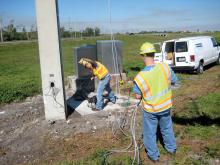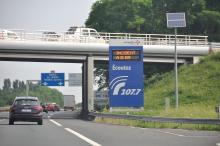Citizen reporting offers the potential of gathering timely information about road conditions without the need to invest heavily in equipment or to dispatch inordinate numbers of staff to visit and report from various locations. What could be better than an army of motorists and other road users sending in reports of conditions they encounter on their journeys?
Back in 2003, Wyoming DOT set up a system of enhanced citizen-assisted reporting as a way of gathering weather-related information on road conditi

Robert Koeberlein
Citizen reporting can be an efficient method of gathering road condition information but requires a degree of standardisation.
Citizen reporting offers the potential of gathering timely information about road conditions without the need to invest heavily in equipment or to dispatch inordinate numbers of staff to visit and report from various locations. What could be better than an army of motorists and other road users sending in reports of conditions they encounter on their journeys?
Back in 2003, Wyoming DOT set up a system of enhanced citizen-assisted reporting as a way of gathering weather-related information on road conditions throughout the winter months. This scheme became an initiative by the North/West Passage Pooled Fund coalition - a grouping of eight northern states between Washington and Wisconsin that collaborate on research into highway-related matters with the view to common implementation of projects with a favourable outcome.
Wyoming has subsequently recruited some 400 volunteers (truck or delivery drivers and individual motorists) who send in regular updates throughout the winter months, sometimes several per day, about the weather-related road conditions they are experiencing. “Initially these reports were filed by telephone to Wyoming DOT staff who then entered the details on the 511 website,” says Robert Koeberlein, mobility services engineer with7477 Idaho Transportation Department (ITD), who delivered a paper on the topic at 560 ITS America in Tennessee.
Koeberlein, who is involved in developing and implementing a citizen reporting system for Idaho, is keen to build on Wyoming’s experience and to ensure the two systems will work together. He told1846 ITS International: “There will be many occasions when both the volunteer citizen reporters and members of the public travel across state lines and the whole idea of the North/West Passage Program is that all the member states pursue common goals and use common road condition descriptions.”
Being the lead state Wyoming has already improved the system and continues to do so. One upgrade involves streamlining the input system to enable authorised citizens to report conditions to DOT staff through a web interface, however Koeberlein is looking to go one step further when Idaho’s system goes live in the autumn. “We want to allow the volunteers to make updates directly onto the 511 webpage without ITD staff as an intermediary - although we will retain oversight,” he says.
In common with other agencies, Idaho does not want to encourage drivers to log reports while on the move, so the web interface is designed for use at a workstation or on a laptop rather than via a mobile phone app. “Truck drivers will send in reports when they stop for their rest periods,” says Koeberlein. He accepts this means there will be a delay of an hour or two in the 511 websites and phone being updated but says this will still be far more frequent that has previously been the case.
Idaho currently distributes road conditions information via its 511 telephone and websites, a network of 54 variable message signs across the state and 25 AM radio transmitters. However, the information currently delivered via these means is gathered on a scheduled basis from ITD Maintenance staff, with additional ad-hoc reports as conditions change. “We see citizen reporting as extending our capability and providing a better driver information service without the need to expand our maintenance staff reporting,” Koeberlein says.
Direct web-entry is now on the horizon in both Wyoming and Idaho. “In order to do this uniformly and consistently there needs to be a number of standardised phrases that could be used by all the volunteers,” Koeberlein says. If the idea is successful, citizen reporting could be used across all eight states so it is important to select phrases that are acceptable to all members and therefore wider input was needed in compiling the list. Fortunately, the North/West Passage group had already done some work in standardising the descriptions shown on the member states’ 511 websites and this could be utilised. Initially it found five terms to define a dry winter road (see illustration), and this has been replaced by a single unified term: ‘Dry’.
Not only will the use of standardise reporting procedures, phrases and definitions on 511 websites help travellers who cross state boundaries, Wyoming DOT’s maintenance staff have also adopted the terms and categories to aid its internal communications.
The volunteers from Wyoming are already receiving their training but as Idaho only finalised its system in early spring, it will not go live until late October or November. “We could have done the recruiting and training in the spring but it would then mean the volunteers wouldn’t put their training into practice for six months,” says Koeberlein.
Idaho is just starting the recruiting and training of citizen reporter volunteers ready for the oncoming winter and the input they provide will complement the current information flow from state employees. Koeberlein says: “We are hoping to recruit individuals who travel regular routes and those who are on the road most of the day such as truck drivers, delivery drivers and so on. ITD also intends to recruit drivers from the private transit fleet operated by the Idaho National Laboratory in eastern Idaho.
This type of driver is experienced and always knows exactly where they encounter something to report and have regular stops when they have access to a computer to upload the information. The Wyoming DOT has found the parcel delivery drivers particularly helpful in gathering and uploading information.”
In addition to collaborating with Idaho, Wyoming DOT is working with the Utah DOT to help the neighbouring state expand its own citizen reporting system. All three states are sharing the common list of reporting phrases in order to continue the consistency across all the participating states. Utah DOT has developed a mobile app for citizen reports and Wyoming DOT plans to adopt this process in the next phase of its citizen reporting system.
The plan is for the other states in the North/West Passage Program to evaluate how Idaho’s implementation works before deciding if they are ready to implement their own citizen reporting schemes. For his part Koeberlein believes that when Idaho’s system is up and running it could be expanded to include other features such as road defect reporting.
He sums up motivation behind the move by saying: “Utilising the public’s willingness to help the state provide a better information service within the same budget has to be good for both drivers and the tax payer.”
Citizen reporting or crowd sourcing?
Transportation authorities can utilise the goodwill of the travelling public to gather information about travel conditions either by citizen reporting or by ‘crowd sourcing’.
Generally citizen reporters, as with Wyoming and Idaho road condition case, need to have already registered, received accreditation and possibly training before they can submit information. With crowd sourcing members of the public can contribute to a particular service (such as monitoring train services for overcrowded or late-running) without necessarily having prior accreditation.
Many crowd sourcing systems use apps or non-password protected website as a means of submitting information and limit the user’s choice of terms rather than providing a free text area. This information is then posted on website to inform other travellers.
ITD decided against crowd sourcing because it wanted to control the quality and reliability of the information submitted by pre-qualifying and providing initial training to the volunteers and will monitor the information provided. “We feel anonymous crowd sourcing does not provide these needs and are also avoiding activities that could cause driver distraction such as smart phone reporting,” says Koeberlein.
Wyoming DOT did consider WAZE and other options for crowd sourcing but was concerned that without training, the way the conditions were reported would vary depending on the individual’s experience of winter driving.
Citizen reporting offers the potential of gathering timely information about road conditions without the need to invest heavily in equipment or to dispatch inordinate numbers of staff to visit and report from various locations. What could be better than an army of motorists and other road users sending in reports of conditions they encounter on their journeys?
Back in 2003, Wyoming DOT set up a system of enhanced citizen-assisted reporting as a way of gathering weather-related information on road conditions throughout the winter months. This scheme became an initiative by the North/West Passage Pooled Fund coalition - a grouping of eight northern states between Washington and Wisconsin that collaborate on research into highway-related matters with the view to common implementation of projects with a favourable outcome.
Wyoming has subsequently recruited some 400 volunteers (truck or delivery drivers and individual motorists) who send in regular updates throughout the winter months, sometimes several per day, about the weather-related road conditions they are experiencing. “Initially these reports were filed by telephone to Wyoming DOT staff who then entered the details on the 511 website,” says Robert Koeberlein, mobility services engineer with
Koeberlein, who is involved in developing and implementing a citizen reporting system for Idaho, is keen to build on Wyoming’s experience and to ensure the two systems will work together. He told
Being the lead state Wyoming has already improved the system and continues to do so. One upgrade involves streamlining the input system to enable authorised citizens to report conditions to DOT staff through a web interface, however Koeberlein is looking to go one step further when Idaho’s system goes live in the autumn. “We want to allow the volunteers to make updates directly onto the 511 webpage without ITD staff as an intermediary - although we will retain oversight,” he says.
In common with other agencies, Idaho does not want to encourage drivers to log reports while on the move, so the web interface is designed for use at a workstation or on a laptop rather than via a mobile phone app. “Truck drivers will send in reports when they stop for their rest periods,” says Koeberlein. He accepts this means there will be a delay of an hour or two in the 511 websites and phone being updated but says this will still be far more frequent that has previously been the case.
Idaho currently distributes road conditions information via its 511 telephone and websites, a network of 54 variable message signs across the state and 25 AM radio transmitters. However, the information currently delivered via these means is gathered on a scheduled basis from ITD Maintenance staff, with additional ad-hoc reports as conditions change. “We see citizen reporting as extending our capability and providing a better driver information service without the need to expand our maintenance staff reporting,” Koeberlein says.
Direct web-entry is now on the horizon in both Wyoming and Idaho. “In order to do this uniformly and consistently there needs to be a number of standardised phrases that could be used by all the volunteers,” Koeberlein says. If the idea is successful, citizen reporting could be used across all eight states so it is important to select phrases that are acceptable to all members and therefore wider input was needed in compiling the list. Fortunately, the North/West Passage group had already done some work in standardising the descriptions shown on the member states’ 511 websites and this could be utilised. Initially it found five terms to define a dry winter road (see illustration), and this has been replaced by a single unified term: ‘Dry’.
Not only will the use of standardise reporting procedures, phrases and definitions on 511 websites help travellers who cross state boundaries, Wyoming DOT’s maintenance staff have also adopted the terms and categories to aid its internal communications.
The volunteers from Wyoming are already receiving their training but as Idaho only finalised its system in early spring, it will not go live until late October or November. “We could have done the recruiting and training in the spring but it would then mean the volunteers wouldn’t put their training into practice for six months,” says Koeberlein.
Idaho is just starting the recruiting and training of citizen reporter volunteers ready for the oncoming winter and the input they provide will complement the current information flow from state employees. Koeberlein says: “We are hoping to recruit individuals who travel regular routes and those who are on the road most of the day such as truck drivers, delivery drivers and so on. ITD also intends to recruit drivers from the private transit fleet operated by the Idaho National Laboratory in eastern Idaho.
This type of driver is experienced and always knows exactly where they encounter something to report and have regular stops when they have access to a computer to upload the information. The Wyoming DOT has found the parcel delivery drivers particularly helpful in gathering and uploading information.”
In addition to collaborating with Idaho, Wyoming DOT is working with the Utah DOT to help the neighbouring state expand its own citizen reporting system. All three states are sharing the common list of reporting phrases in order to continue the consistency across all the participating states. Utah DOT has developed a mobile app for citizen reports and Wyoming DOT plans to adopt this process in the next phase of its citizen reporting system.
The plan is for the other states in the North/West Passage Program to evaluate how Idaho’s implementation works before deciding if they are ready to implement their own citizen reporting schemes. For his part Koeberlein believes that when Idaho’s system is up and running it could be expanded to include other features such as road defect reporting.
He sums up motivation behind the move by saying: “Utilising the public’s willingness to help the state provide a better information service within the same budget has to be good for both drivers and the tax payer.”
Citizen reporting or crowd sourcing?
Transportation authorities can utilise the goodwill of the travelling public to gather information about travel conditions either by citizen reporting or by ‘crowd sourcing’.
Generally citizen reporters, as with Wyoming and Idaho road condition case, need to have already registered, received accreditation and possibly training before they can submit information. With crowd sourcing members of the public can contribute to a particular service (such as monitoring train services for overcrowded or late-running) without necessarily having prior accreditation.
Many crowd sourcing systems use apps or non-password protected website as a means of submitting information and limit the user’s choice of terms rather than providing a free text area. This information is then posted on website to inform other travellers.
ITD decided against crowd sourcing because it wanted to control the quality and reliability of the information submitted by pre-qualifying and providing initial training to the volunteers and will monitor the information provided. “We feel anonymous crowd sourcing does not provide these needs and are also avoiding activities that could cause driver distraction such as smart phone reporting,” says Koeberlein.
Wyoming DOT did consider WAZE and other options for crowd sourcing but was concerned that without training, the way the conditions were reported would vary depending on the individual’s experience of winter driving.










